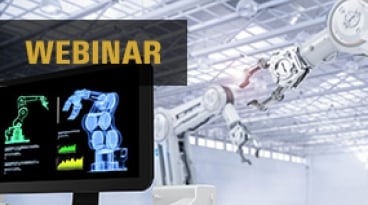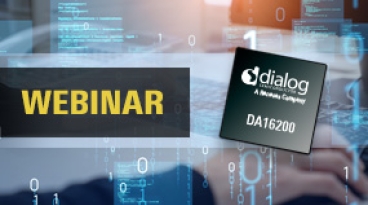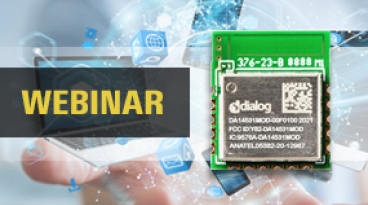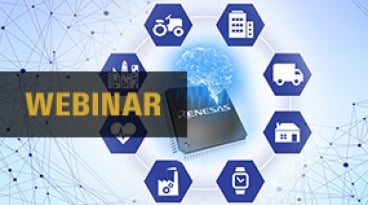Results: 150 webinars
Sensor Products, Automotive Products
Automotive, Electric & Hybrid Vehicles (EV)
In this free, 60-minute webinar, Guanyuan Chen of Renesas explains how to combine an inductive position sensor (IPS) with an xEV inverter solution to reduce costs and the bill of materials (BOM) when compared to using a resolver.
Chengzhe Li will explain how the xEV inverter application model and software control the motor, reducing software development time and effort.
Key topics and takeaways:
Learn how to reduce BOM components by using IPS, which is 30% less expensive than resolvers
Find out how to save time when achieving noise immunity by utilizing a pre-verified high voltage inverter environment (400V, 100kW, 500Arms)
Discover how to reduce potential rework through simulation at the design stage by using sample application IGBT models
Learn how to reduce application software programming effort by automatically generating sample application software
Find out how to reduce driver software programming effort using driver software whose operation has been confirmed on the reference board
Chengzhe Li will explain how the xEV inverter application model and software control the motor, reducing software development time and effort.
Key topics and takeaways:
Learn how to reduce BOM components by using IPS, which is 30% less expensive than resolvers
Find out how to save time when achieving noise immunity by utilizing a pre-verified high voltage inverter environment (400V, 100kW, 500Arms)
Discover how to reduce potential rework through simulation at the design stage by using sample application IGBT models
Learn how to reduce application software programming effort by automatically generating sample application software
Find out how to reduce driver software programming effort using driver software whose operation has been confirmed on the reference board
Microcontrollers & Microprocessors
Wireless Infrastructure
In this webinar you will learn:
• Types of applications that can most benefit from the combination of Panthronics NFC ICs and Renesas RA MCUs
• Details on IoT card readers, Point of Sale terminals, and wireless charging use cases
• How to use Renesas Winning Combination reference designs, Quick-Connect IoT Pmods and Panthronics Pmod expansion boards, which can significantly reduce your development time
• How to enable a secure NFC application in the shortest amount of time for numerous cost sensitive consumer and robust industrial applications
• Types of applications that can most benefit from the combination of Panthronics NFC ICs and Renesas RA MCUs
• Details on IoT card readers, Point of Sale terminals, and wireless charging use cases
• How to use Renesas Winning Combination reference designs, Quick-Connect IoT Pmods and Panthronics Pmod expansion boards, which can significantly reduce your development time
• How to enable a secure NFC application in the shortest amount of time for numerous cost sensitive consumer and robust industrial applications
Microcontrollers & Microprocessors
Metering
In this webinar, viewers will learn how easily a manufacturer can empower its devices with the DLMS protocol using Terranova's Smart Meter Library. DLMS / COSEM (IEC 62056, AINSI C12, EN13757-1) is the global standard for energy and water smart management, advanced control, and innovative metering.
Webinar topics:
- Analyze key features of the product
- Examine the technical benefits and overall architecture
- Highlight the RA and RL78 platform support
Webinar topics:
- Analyze key features of the product
- Examine the technical benefits and overall architecture
- Highlight the RA and RL78 platform support
In this webinar, you will learn:
- What O-RAN is and its advantages over traditional RAN topologies
- Timing topologies and requirements for each of the four synchronization plane configuration modes as defined by the O-RAN Alliance
- How Renesas' complete HW and SW timing solutions, with ClockMatrix hardware and PCM4L software, meet the O-RAN timing requirements for all configuration modes
- Benefits of using Renesas' ClockMatrix Family of synchronizers to guarantee both synchronization and low-noise sampling clocks for the RF converters and LO
- Benefits of using Renesas' PTP Clock Manager Software for Linux (PCM4L) with the ClockMatrix Family of synchronizers to guarantee IEEE 1588 compliance
- How the PMOD type 6A hardware architecture makes it simple to connect to any Renesas development kit
- How the integrated software reduces integration effort by providing software libraries and simple software APIs
- How the combined hardware and software solution of the Renesas Quick Connect system simplifies the transition from prototype to production
- What O-RAN is and its advantages over traditional RAN topologies
- Timing topologies and requirements for each of the four synchronization plane configuration modes as defined by the O-RAN Alliance
- How Renesas' complete HW and SW timing solutions, with ClockMatrix hardware and PCM4L software, meet the O-RAN timing requirements for all configuration modes
- Benefits of using Renesas' ClockMatrix Family of synchronizers to guarantee both synchronization and low-noise sampling clocks for the RF converters and LO
- Benefits of using Renesas' PTP Clock Manager Software for Linux (PCM4L) with the ClockMatrix Family of synchronizers to guarantee IEEE 1588 compliance
- How the PMOD type 6A hardware architecture makes it simple to connect to any Renesas development kit
- How the integrated software reduces integration effort by providing software libraries and simple software APIs
- How the combined hardware and software solution of the Renesas Quick Connect system simplifies the transition from prototype to production
Microcontrollers & Microprocessors
Industrial
In this webinar, you will learn about the benefits RZ/T2M brings:
1) The real time dual-core Arm® Cortex®-R52 processor subsystem with many motor control peripherals guaranteeing μSec control loops
2) The innovative industrial ethernet subsystem including the future proof support for Time Sensitive Networking (TSN)
3) The extensive support for functional safety implementation, reducing the number of external processers needed for SIL3 applications
1) The real time dual-core Arm® Cortex®-R52 processor subsystem with many motor control peripherals guaranteeing μSec control loops
2) The innovative industrial ethernet subsystem including the future proof support for Time Sensitive Networking (TSN)
3) The extensive support for functional safety implementation, reducing the number of external processers needed for SIL3 applications
Microcontrollers & Microprocessors
In this session, we will examine the implementation of Trustzone-M in Renesas Cortex-M33 based RA4 and RA6 MCUs, along with the additional features that build on top of this to further enhance embedded security. Also covered will be the software development tools that provide the necessary workflows to allow customers to deliver a secure system.
Microcontrollers & Microprocessors
Motor Drives & Robotics
eProsima is the company behind micro-ROS and it is key-partnering with Renesas. The Renesas RA Family of microcontrollers is the micro-ROS recommended MCU and provides professional technical support at [email protected]. This webinar gives you the key insights of ROS and micro-ROS. We will demonstrate how to develop open source robotic applications using the RA Family.
During this webinar, we're going to:
- Highlight the key functionality of the DA16200 Ultra-Low Power Wi-Fi SoC
- Highlight and explain the extended AT Command functionality
- Show wi-fi implementation details on the RA6M4 MCU host
- Demonstrate ready-to-go ultra-low power wi-fi using Renesas RA6 Series MCUs as an example using the SparkFun Wi-Fi Shield
- Highlight the key functionality of the DA16200 Ultra-Low Power Wi-Fi SoC
- Highlight and explain the extended AT Command functionality
- Show wi-fi implementation details on the RA6M4 MCU host
- Demonstrate ready-to-go ultra-low power wi-fi using Renesas RA6 Series MCUs as an example using the SparkFun Wi-Fi Shield
Automotive Products
Automotive, Renewable Energy & Grid
Renesas is contributing to the acceleration of customer development through our Winning Combination system solutions. The Webinar is focusing on two xEV applications, BMS*1 & inverter. For BMS, our application model & software solution reduces R&D*2 effort by providing sample application models that estimates SOC*3 & SOH*4. For xEV inverter, Renesas can help customers shorten development time by supporting system level functional safety.
*1 Battery Management System, *2 Research and Development, *3 State Of Charge, *4 State Of Health
Key takeaways
Jumpstart the process of learning the Renesas environment
Speed up time to market with sample models, reducing rework in BMS development
Reduce both application software and firmware development effort for BMS
Support for functional safety concept reduces development time at the system level for xEV inverter
Speakers:
Mr. Masuo Okuda, Senior Manager, Automotive Analog Marketing and Advanced Engineering Department, Automotive Analog Product Marketing Division, Renesas Electronics Inc.
Mr. Masashi Tsubota, Senior Principal Specialist, Automotive Analog Marketing and Advanced Engineering Department, Automotive Analog Product Marketing Division, Renesas Electronics Inc.
*1 Battery Management System, *2 Research and Development, *3 State Of Charge, *4 State Of Health
Key takeaways
Jumpstart the process of learning the Renesas environment
Speed up time to market with sample models, reducing rework in BMS development
Reduce both application software and firmware development effort for BMS
Support for functional safety concept reduces development time at the system level for xEV inverter
Speakers:
Mr. Masuo Okuda, Senior Manager, Automotive Analog Marketing and Advanced Engineering Department, Automotive Analog Product Marketing Division, Renesas Electronics Inc.
Mr. Masashi Tsubota, Senior Principal Specialist, Automotive Analog Marketing and Advanced Engineering Department, Automotive Analog Product Marketing Division, Renesas Electronics Inc.
Microcontrollers & Microprocessors
Artificial Intelligence (AI)
With the rising demand for real-time recognition applications using AI, increasing power consumption and heat generation required for AI processing are becoming common issues faced by many developers. In addition to technical requirements, cost-effective solutions are the key to expand endpoint vision AI markets.
Below are the three main issues faced while implementing cost-effective solutions.
1. Realize both high-speed AI inference and low power consumption
2. System cost reduction
3. Efficient product development
Join this webinar to learn how Renesas' RZ/V series MPUs can help confront all the three issues.
Below are the three main issues faced while implementing cost-effective solutions.
1. Realize both high-speed AI inference and low power consumption
2. System cost reduction
3. Efficient product development
Join this webinar to learn how Renesas' RZ/V series MPUs can help confront all the three issues.
In this webinar you will learn:
- The TINY™ Module: content, design, package, etc.
- Worldwide certification
- Development kit
- CodeLess SW development and ready-to-use examples
- Resources and support
- How quick and easy it is to develop your new products with the DA14531 SmartBond TINY™ Module
- The TINY™ Module: content, design, package, etc.
- Worldwide certification
- Development kit
- CodeLess SW development and ready-to-use examples
- Resources and support
- How quick and easy it is to develop your new products with the DA14531 SmartBond TINY™ Module
As customers move towards Brushless DC (BLDC) from traditional brushed motors to take advantage of the power efficiency, torque efficacy, size and reliability benefits, there are new design considerations to understand. Unlike brushed motors with a mechanical commutator, BLDC motors need an electronic commutator which can be more challenging to implement. This webinar will address these challenges and show how Renesas solutions can make it easy to drive BLDC motors with new tools, resources, and algorithms.
Microcontrollers & Microprocessors
Artificial Intelligence (AI)
In this webinar, we will discuss:
- How endpoint intelligence will have a profound impact on how we interact with IoT devices
- Renesas technologies and solutions to help increase endpoint intelligence for a wide range of applications
- The evolution of artificial intelligence (AI)
- AI / Machine Learning technology, landscape, and construct
- Robust end-to-end security
- Use case examples
- How endpoint intelligence will have a profound impact on how we interact with IoT devices
- Renesas technologies and solutions to help increase endpoint intelligence for a wide range of applications
- The evolution of artificial intelligence (AI)
- AI / Machine Learning technology, landscape, and construct
- Robust end-to-end security
- Use case examples
In this webinar, we will explore how active beamforming ICs can simplify phased array antennas for 5G, Satcom and Radar applications.
Three generations of active beamforming ICs based on highly integrated silicon technology have led to the commercialization of active phased array antennas for a variety of systems. This session will review common antenna architectures and design challenges of phased array antennas. We will delve into the features that simplify product design and reduce time to market, such as compact size, high power efficiency, Dynamic Array Power (DAP™), ArraySense™ and RapidBeam™ technologies.
Three generations of active beamforming ICs based on highly integrated silicon technology have led to the commercialization of active phased array antennas for a variety of systems. This session will review common antenna architectures and design challenges of phased array antennas. We will delve into the features that simplify product design and reduce time to market, such as compact size, high power efficiency, Dynamic Array Power (DAP™), ArraySense™ and RapidBeam™ technologies.
Microcontrollers & Microprocessors
During this webinar, you will learn about what makes Storyboard different for your embedded GUI development. You will also learn different techniques for asset, memory, and resource optimization, how to fine-tune GUI performance, and how to deploy our demo image onto the Renesas RA6M3 platform.














